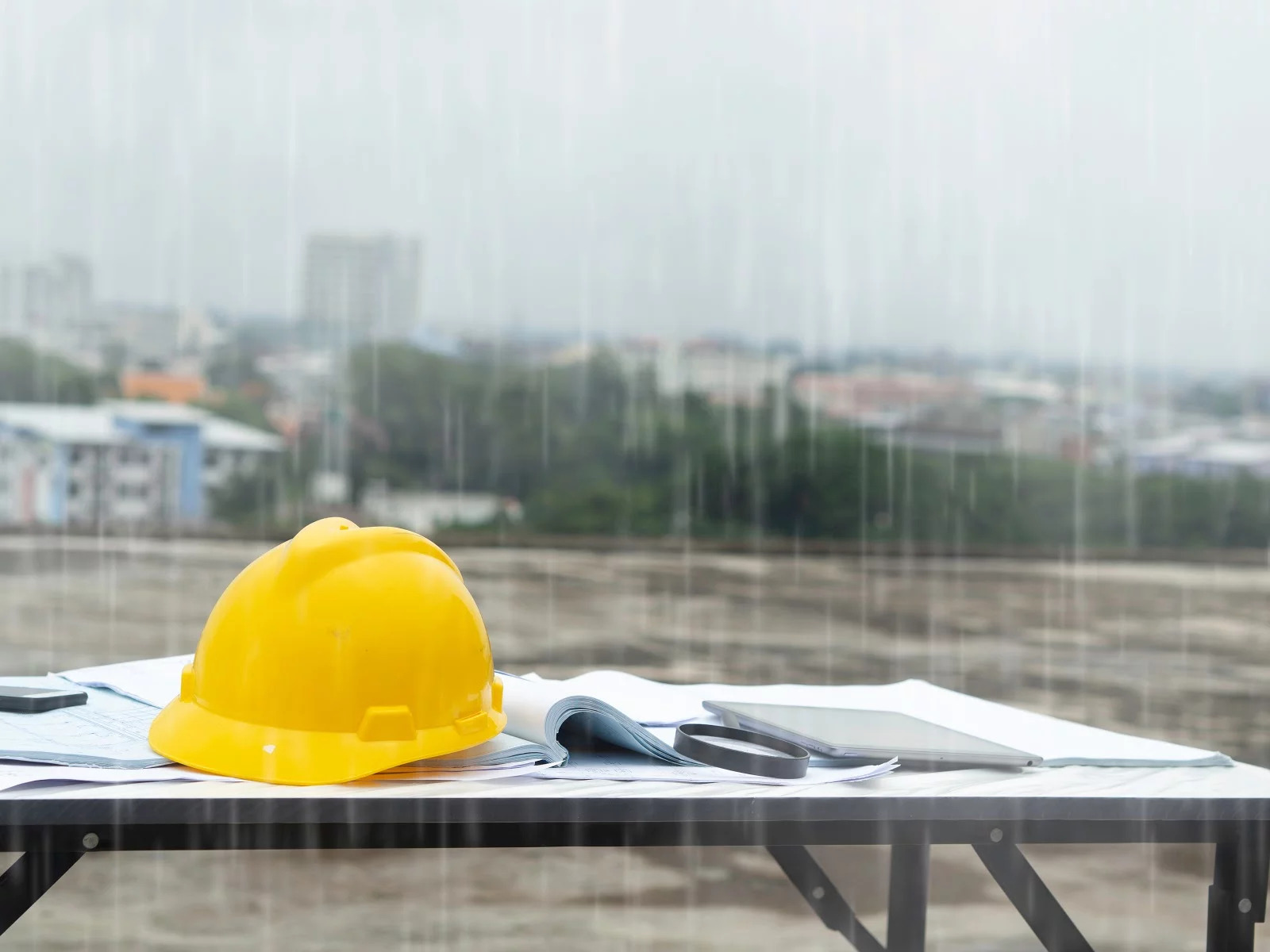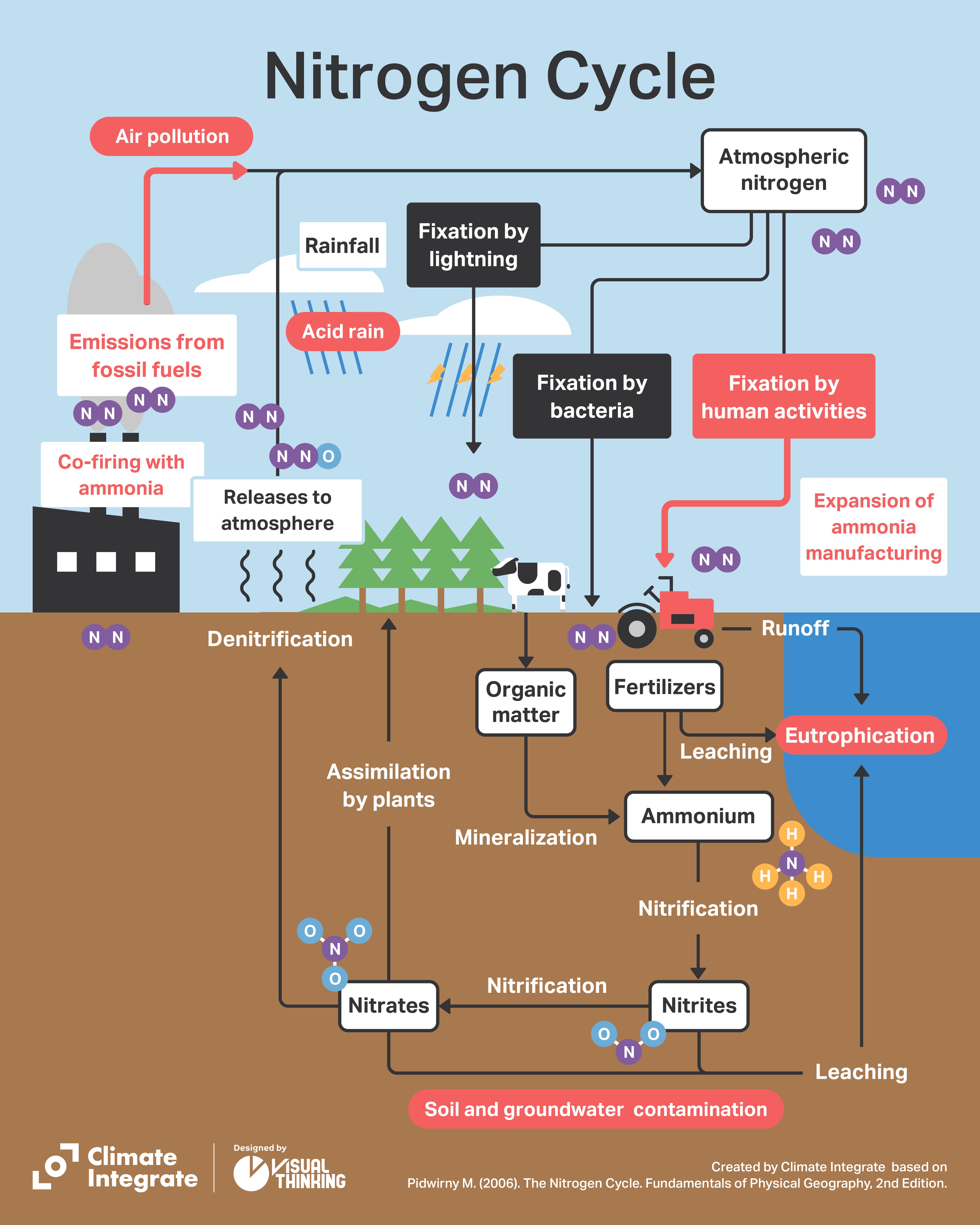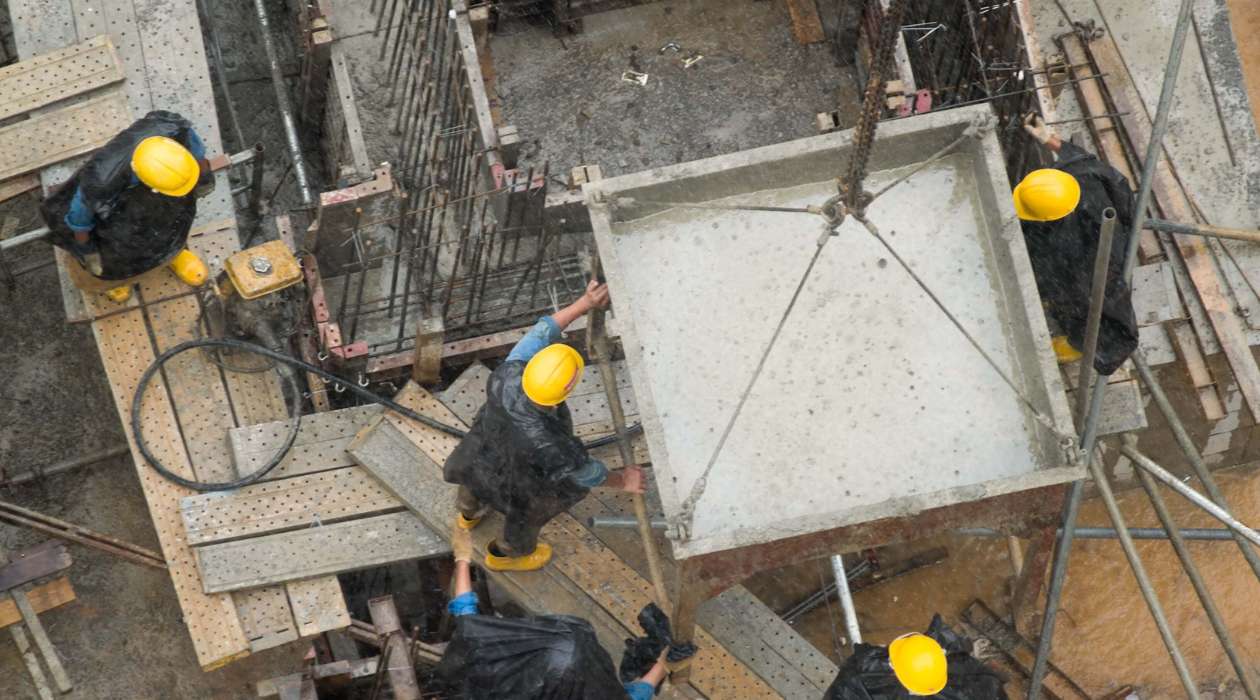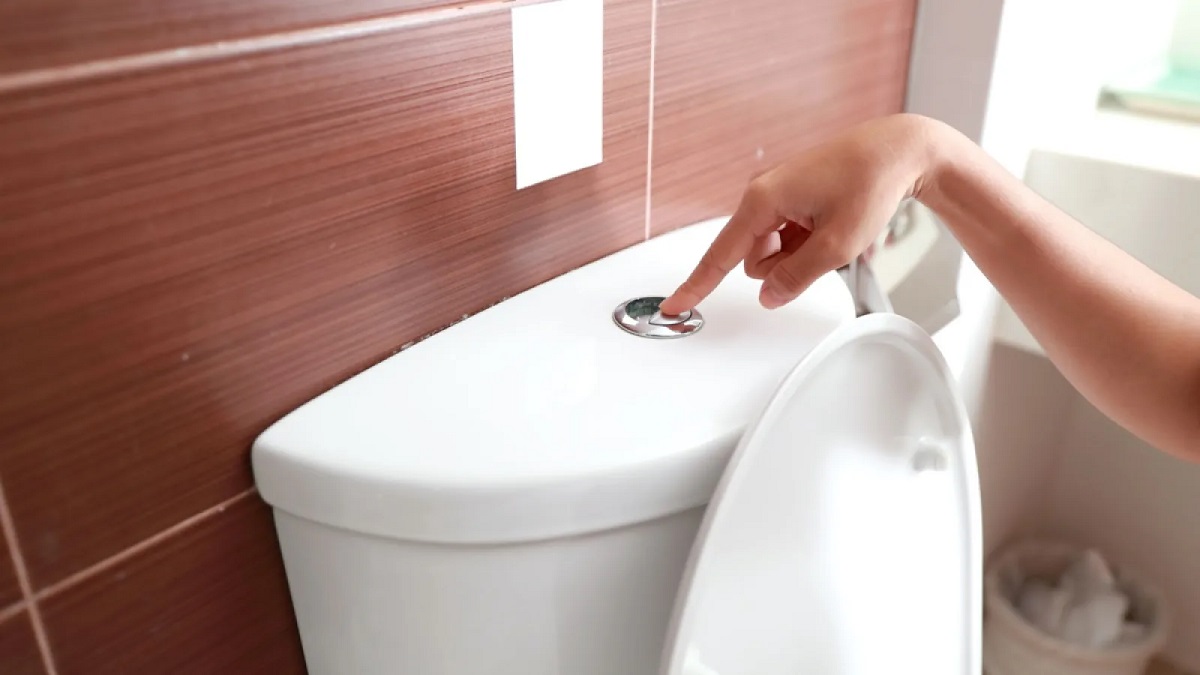Home>diy>Building & Construction>How Does Rain Affect Construction


Building & Construction
How Does Rain Affect Construction
Modified: January 5, 2024
Discover how rain impacts building construction and learn the potential challenges and solutions for weather-related issues in the construction industry.
(Many of the links in this article redirect to a specific reviewed product. Your purchase of these products through affiliate links helps to generate commission for Storables.com, at no extra cost. Learn more)
Introduction
When it comes to construction projects, there are numerous factors that need to be considered. From materials and equipment to labor and planning, every aspect plays a crucial role in the successful completion of a project. However, one factor that often gets overlooked but can have a significant impact is rain. Rainfall can significantly affect construction projects in various ways, causing delays, damaging materials, and increasing costs. Therefore, it is essential for construction professionals to understand the effects of rain and implement measures to mitigate its impact.
In this article, we will explore the importance of considering rain in construction and delve into the effects it can have on construction projects. We will also discuss several measures that can be taken to minimize the impact of rain and ensure the smooth progress of construction activities.
Key Takeaways:
- Proactive planning, proper site preparation, and regular maintenance are essential to mitigate the impact of rain on construction projects, ensuring successful completion and minimizing delays and costs.
- Implementing protective coverings, effective drainage systems, and worker safety measures can safeguard materials, equipment, and workers, reducing the negative effects of rain on construction projects.
Read more: How Does Construction Affect Wildlife
Importance of Considering Rain in Construction
Rain is a natural phenomenon that can have a significant impact on construction projects. Ignoring the potential effects of rain can lead to project delays, increased costs, and compromised quality of workmanship. Therefore, it is crucial for construction professionals to prioritize and plan for the potential challenges brought about by rainfall.
First and foremost, rain can cause delays in the construction schedule. Heavy rainfall can make the construction site muddy and slippery, making it unsafe for workers to continue their tasks. In addition, wet conditions can hinder the proper curing of concrete, resulting in longer drying times and delaying subsequent construction activities. By considering rain in the construction planning stage, project managers can allocate additional time for potential weather-related delays and adjust the schedule accordingly.
Furthermore, rain can cause damage to construction materials and equipment. Wood, for example, can easily absorb moisture, leading to warping, cracking, and rotting. Steel structures and equipment can be prone to rusting when exposed to water for prolonged periods. By taking precautions such as covering materials and equipment or storing them in weather-protected areas, construction professionals can minimize the risk of damage and potential replacement costs.
Another crucial aspect to consider is the quality of workmanship. Working in wet conditions can lead to the improper installation of materials, as they may not adhere properly or dry as intended. This can result in compromised structural integrity and the need for rework, leading to additional time and costs. By accounting for rain in construction planning, workers can be scheduled to work during dry periods, ensuring better quality control.
Safety hazards for workers are also a major concern when it comes to rain and construction. Slippery surfaces, poor visibility, and unstable ground conditions can increase the risk of accidents and injuries. Construction sites that are not adequately prepared for rain can pose a serious threat to workers’ safety. By implementing measures such as proper drainage systems, non-slip flooring, and safety training, construction professionals can mitigate these risks and provide a safe working environment for their employees.
Lastly, rain can have a direct impact on the overall cost of construction projects. Delays in the schedule, damage to materials, and the need for additional safety measures can all contribute to increased expenses. By taking proactive measures to address rain-related challenges, construction professionals can minimize the financial impact and ensure that projects stay within budget.
In summary, considering rain in construction is of utmost importance. By recognizing the potential effects of rain and implementing appropriate measures, construction professionals can navigate through the challenges posed by rainfall, reduce project delays, protect materials and equipment, maintain quality workmanship, ensure worker safety, and ultimately save costs. Planning and preparedness are key in successfully managing rainfall and ensuring the smooth progress of construction projects.
Effects of Rain on Construction Projects
Rainfall can have significant effects on construction projects, impacting various aspects of the project’s progress and outcomes. It is important to be aware of these effects in order to develop strategies to mitigate their impact and ensure the successful completion of construction projects.
1. Delays in Construction Schedule
One of the most immediate effects of rain on construction projects is the delay in the construction schedule. Heavy rainfall can make the construction site unsafe and muddy, making it difficult for workers to carry out their tasks. Wet conditions can also lead to the postponement of concrete pouring or curing, which can disrupt the sequence of construction activities. These delays can have a cascading effect on the overall project timeline, resulting in additional costs and resources needed to adjust the schedule.
2. Damage to Materials and Equipment
Rainwater can cause damage to construction materials and equipment. Wood and plywood, for example, are susceptible to swelling, warping, and rotting when exposed to excessive moisture. Steel can rust when exposed to rain, compromising its structural integrity. Construction equipment can also be affected, leading to malfunction or the need for repairs. This damage not only results in additional costs but can also impact the quality of workmanship and the overall longevity of the construction project.
3. Poor Quality Workmanship
Working in wet conditions can lead to poor quality workmanship. Wet surfaces can affect the adhesion and curing of materials such as adhesives, sealants, and coatings, resulting in compromised performance and durability. Precise measurements and installation techniques may also be more challenging in rainy weather, leading to inaccuracies and subpar work. This can impact the overall quality of the construction project and may require rework or repairs in the future.
4. Safety Hazards for Workers
Rainy conditions increase the risk of accidents and injuries on construction sites. Slippery surfaces, reduced visibility, and unstable ground conditions can all contribute to hazardous working conditions. Workers may experience slips, trips, and falls, leading to injuries that can range from minor to severe. It is crucial to implement proper safety measures, such as non-slip flooring, suitable protective gear, and training, to mitigate these risks and ensure the well-being of workers.
5. Increased Construction Costs
The effects of rain on construction projects can result in increased costs. Delays in the schedule may require additional resources and overtime pay, adding to the project’s budget. Damage to materials and equipment may necessitate replacements or repairs, incurring extra expenses. Poor workmanship may require rework or corrections, leading to additional labor and material costs. Implementing safety measures to mitigate rain-related risks can also add to the overall project costs. These increased expenses can strain the project’s budget and potentially impact profitability.
Understanding the effects of rain on construction projects is crucial for proper planning and implementation. By anticipating these impacts and taking appropriate measures, such as adjusting the construction schedule, protecting materials and equipment, maintaining quality workmanship, ensuring worker safety, and accounting for potential cost overruns, construction professionals can minimize the negative effects and successfully navigate through rainy weather conditions.
Delays in Construction Schedule
One of the most significant effects of rain on construction projects is the potential for delays in the construction schedule. Rainfall can make construction sites wet, muddy, and slippery, which can make it unsafe for workers to carry out their tasks. Construction activities such as excavation, foundation work, and concrete pouring may need to be postponed or halted altogether due to the adverse weather conditions.
When heavy rain occurs, construction sites can become flooded, making it impossible for work to continue until the water recedes. Additionally, rain can lead to unstable ground conditions, further complicating construction work. Precise measurements, leveling, and grading activities may be postponed until the ground dries out and stabilizes, causing delays in the overall construction timeline.
Delays in the construction schedule can have a domino effect on the project as a whole. Each construction activity is typically dependent on the completion of the previous task, and any delay can disrupt the entire sequence of events. Subcontractors and suppliers may need to be rescheduled, and resources such as equipment and materials may need to be rearranged. This can lead to a ripple effect of delays and complicate project coordination and management.
In addition to the immediate impact on the construction process, delays in the schedule can also have financial implications. Construction projects are often time-sensitive, and any delay can result in increased labor costs, extended rental fees for equipment, and potential contract penalties for failing to meet project deadlines. Furthermore, the delay may also affect other parties involved, such as developers or clients, who may have planned subsequent activities based on the original schedule.
To mitigate the impact of rain-induced delays, proactive planning and contingency measures are crucial. Construction professionals can develop a robust construction schedule that accounts for potential weather-related delays, allowing for flexibility and buffer time. This can help to absorb any unexpected weather challenges and reduce the impact on the overall project timeline.
Implementing measures such as proper drainage systems, temporary shelter structures, and site preparation techniques can also help mitigate the effects of rain. By ensuring effective drainage of rainwater and creating suitable working conditions, construction sites can be better equipped to handle rainfall and minimize delays.
Communication and coordination among all stakeholders are essential in managing delays caused by rain. Regular communication with subcontractors, suppliers, and project owners can help everyone stay informed about potential delays and adjustments to the schedule. This allows for efficient planning and allocation of resources, reducing the impact of rain-related delays on the construction project.
Overall, delays in the construction schedule due to rain can be a significant challenge. However, with proper planning, proactive measures, and effective communication, construction professionals can minimize the impact of rain-induced delays and ensure the successful completion of the project.
Read more: How Much Does Infill Affect Strength
Damage to Materials and Equipment
Rainfall can cause significant damage to construction materials and equipment, leading to costly repairs, replacements, and potential compromises in the quality of the project. It is essential to understand the potential risks and take proactive measures to protect these valuable resources.
One of the primary materials at risk of damage from rain is wood. Wood absorbs water, which can lead to swelling, warping, and eventual decay. This can compromise the structural integrity of wooden components such as framing, flooring, and paneling. Exposed wood can also become a breeding ground for mold and mildew, further compromising its stability and aesthetic appeal.
Concrete and masonry materials, although less susceptible to water damage compared to wood, can still be adversely affected. Rainwater can seep into concrete and cause it to crack or weaken over time. Wet conditions can also hinder the proper curing of concrete, resulting in weaker structures. Masonry materials such as bricks and mortar can absorb water, leading to reduced strength and durability.
In addition to materials, construction equipment is also vulnerable to rain damage. Heavy rainfall can result in water seeping into equipment engines, such as generators or pumps, causing mechanical failures. Exposure to rain can also lead to corrosion of metal components, which can compromise their functionality and lifespan. Electrical equipment can be especially at risk during rainy weather, with the potential for water-induced short circuits and equipment malfunctions.
To mitigate the damage caused by rain, protective measures should be implemented. Construction sites should be properly covered and secured to prevent water from reaching vulnerable materials and equipment. Tarpaulins, temporary roofs, and waterproof enclosures can be used to shield construction areas. Adequate drainage systems should also be in place to redirect rainwater away from construction materials and equipment storage areas.
It is also important to store construction materials and equipment properly during rainy periods. Materials should be kept in covered areas or secured with protective coverings to prevent water absorption. Equipment should be stored in sheltered spaces or covered with tarps to safeguard them from rain exposure. Regular inspections should be conducted to identify any signs of water damage, such as rot, rust, or corrosion, and prompt action should be taken to address these issues.
Furthermore, construction professionals should prioritize the use of water-resistant and weatherproof materials whenever possible. For example, treated or engineered wood products that are more resistant to moisture can be used instead of traditional wood. Waterproofing additives can be applied to concrete and masonry materials to enhance their resistance to water penetration. Selecting construction equipment with weatherproof features can also help mitigate potential damage.
By being proactive in protecting materials and equipment from rain damage, construction professionals can minimize the costs and disruptions associated with repairs and replacements. This not only ensures the integrity and longevity of the construction project but also contributes to maintaining a safe and efficient work environment.
Poor Quality Workmanship
Rainy weather can have a direct impact on the quality of workmanship in construction projects. The challenges posed by rain can make it difficult for workers to perform their tasks effectively, leading to compromised quality and potential issues in the finished product.
One of the main issues that can arise due to rain is the improper installation of materials. Wet conditions can hinder the adhesion and proper curing of construction materials, such as adhesives, sealants, and coatings. This can result in inadequate bonding, reduced durability, and compromised structural integrity of the completed elements. For example, tiles laid in wet conditions may not adhere properly, leading to loose or uneven surfaces.
Furthermore, working in wet conditions can make it challenging to achieve precision and accuracy. Rain can affect visibility, making it difficult for workers to assess alignment, measurements, and other critical aspects of the construction process. This can result in errors, inconsistencies, and a lack of attention to detail, ultimately impacting the overall quality of the project.
Poor weather conditions also increase the likelihood of mistakes and accidents. Workers may rush through tasks in an attempt to complete them before the rain intensifies, leading to errors and subpar workmanship. Moreover, unstable ground conditions caused by rain can make it more difficult to maintain stability while executing construction activities such as excavation or concrete pouring. This can result in uneven foundations, compromised structural stability, and other quality-related issues.
To mitigate the impact of rain on workmanship quality, several measures can be implemented. First and foremost, it is crucial to monitor weather forecasts and plan construction activities accordingly. Whenever possible, it is advisable to schedule critical tasks during dry periods to minimize the risk of poor workmanship due to rain.
Proper training and education of construction workers are also essential. Workers should be trained in the specific challenges associated with working in wet conditions and be equipped with the knowledge and skills to adapt to these conditions effectively. Training programs can focus on techniques for working safely and maintaining quality standards even in adverse weather conditions.
Implementing proper site preparation measures can also contribute to maintaining quality workmanship despite the rain. This includes providing adequate drainage systems to prevent water buildup and ensuring stable working surfaces. Non-slip flooring and appropriate safety measures should also be in place to reduce the risk of accidents and injuries.
Regular inspections and quality control checks should be conducted to identify any issues related to poor workmanship. Prompt actions should be taken to address any deficiencies or errors detected, ensuring that the necessary corrections are made to maintain the desired level of quality.
By prioritizing proper planning, training, site preparation, and quality control, construction professionals can mitigate the potential negative impact of rain on workmanship quality. This not only ensures the longevity and durability of the finished project but also contributes to the overall satisfaction of clients and stakeholders.
Safety Hazards for Workers
Rain in construction sites can create hazardous conditions for workers, increasing the risk of accidents and injuries. Wet surfaces, reduced visibility, and unstable terrain can all contribute to unsafe working conditions, making it crucial to prioritize worker safety during rainy weather.
One of the primary safety hazards posed by rain is the increased risk of slips, trips, and falls. Wet surfaces can become slippery, making it challenging for workers to maintain their balance and stability while walking or performing tasks. This can lead to serious injuries, including sprains, fractures, and head injuries. Additionally, fallen leaves or debris mixed with rainwater can further exacerbate the slipping hazards.
Reduced visibility is another significant safety concern during rainfall. Rain can create a haze or fog-like condition, limiting workers’ vision and making it challenging to see potential hazards or other workers in the vicinity. This can increase the risk of collision accidents, especially when heavy machinery or vehicles are involved. It is essential to ensure proper lighting and visibility measures, such as reflective clothing or tape, to enhance workers’ visibility and minimize the potential for accidents.
Unstable ground conditions are also a safety hazard during rainy weather. Construction sites can become muddy and prone to erosion, leading to uneven surfaces and unstable footing. Working on unstable ground increases the risk of workers losing their balance or equipment toppling over. Excavation work, in particular, becomes more hazardous as rain can cause trenches or excavated areas to collapse, posing grave dangers to workers.
To mitigate safety hazards posed by rain, construction professionals should prioritize and implement proper safety measures. The following are a few key measures that can help improve worker safety:
- Provide proper Personal Protective Equipment (PPE): Workers should be equipped with appropriate PPE, including non-slip safety boots, waterproof clothing, gloves, and helmets, to protect them from potential hazards associated with rain.
- Ensure proper lighting: Adequate lighting should be installed to improve visibility on construction sites during rainy conditions. This will help workers identify potential hazards and navigate safely.
- Implement safety training: Workers should receive comprehensive safety training that addresses the specific hazards posed by rainy weather. This training should cover proper procedures for working in wet conditions, such as how to safely navigate slippery surfaces and operate equipment in adverse weather.
- Establish clear communication: Effective communication among workers and supervisors is crucial during rainy weather. Clear signals and instructions should be established to ensure smooth coordination and minimize the risk of accidents due to miscommunication.
- Regularly inspect and maintain equipment: Equipment should be regularly inspected and maintained to ensure functionality and minimize the risk of malfunctions or accidents due to rain-induced damage or electrical issues.
- Provide proper drainage: Construction sites should be equipped with adequate drainage systems to redirect rainwater and prevent pooling, minimizing the risk of slips and falls.
- Keep work areas clean and clear: Regular clean-up of construction sites, including the removal of debris and fallen leaves, can help reduce slipping hazards.
By implementing these safety measures and fostering a culture of awareness and vigilance, construction professionals can mitigate the safety hazards associated with rainy weather and promote a safer work environment for their workers.
Increased Construction Costs
Rainy weather can result in increased construction costs, as it introduces various challenges and expenses that may not have been accounted for in the initial budget. These increased costs can arise from multiple factors directly related to the impact of rain on construction projects.
One primary factor contributing to increased costs is the potential for project delays. Rain can disrupt the construction schedule, halting or postponing work until weather conditions improve. Delays in the construction timeline can lead to additional labor costs, as workers may need to be paid for extended periods or overtime to compensate for lost productivity. Contractors and subcontractors may also need to reschedule their work, which can result in increased expenses and coordination efforts.
In addition to labor costs, rain can also lead to additional materials costs. The need for protective coverings or tarps to shield materials from rain and potential damage can incur unexpected expenses. Furthermore, if construction materials become damaged by rain, they may need to be replaced, leading to additional procurement costs. For example, water-damaged wood, concrete, or drywall may need to be discarded and replaced, increasing material costs.
Furthermore, rain-induced delays can also result in increased equipment costs. Equipment rentals may need to be extended to account for the additional time required to complete the project. Equipment that is exposed to rain and inclement weather may also require thorough maintenance or repairs, leading to increased servicing costs. These additional expenses can put a strain on the project budget and impact overall profitability.
Another significant cost factor is the potential for rework or repairs due to poor workmanship caused by rain. If construction work is carried out in wet conditions, the quality of the work may be compromised. This can result in the need for corrections or repairs to ensure the project meets the required standards. These additional labor and material costs can significantly impact the overall project budget.
Safety measures to mitigate rain hazards can also contribute to increased costs. For example, the installation of proper drainage systems or the use of non-slip flooring materials may require additional expenses. The provision of adequate personal protective equipment (PPE) for workers during rainy conditions can also increase costs.
To mitigate the impact of increased construction costs due to rain, it is essential to include contingency budgets within the initial project planning stage. These contingency funds can be set aside specifically to address unforeseen weather-related challenges and expenses. Regular monitoring and tracking of costs throughout the project can help identify any cost overruns or deviations from the budget, allowing for necessary adjustments to be made.
Effective project management, including proactive planning and communication, can also contribute to minimizing cost increases. By utilizing accurate weather forecasts and establishing clear communication channels with all stakeholders, construction professionals can anticipate potential delays or extra costs and take prompt action to mitigate their impact.
In summary, rain-induced challenges in construction projects can lead to increased costs. However, by incorporating contingency measures into the budget, implementing effective project management strategies, and prioritizing proactive planning, construction professionals can help mitigate the financial impact of rain and ensure the successful completion of the project within the given budget constraints.
Measures to Mitigate the Impact of Rain in Construction
To mitigate the impact of rain in construction projects, it is essential to implement measures that minimize delays, protect materials and equipment, maintain quality workmanship, ensure worker safety, and control costs. By taking proactive steps, construction professionals can effectively navigate through rainy weather conditions and keep projects on track. Here are some key measures to consider:
- Planning and Scheduling: Incorporate weather considerations into the project plan and schedule. Monitor weather forecasts regularly and adjust the construction timeline accordingly. Allow for additional time in the schedule to account for potential rain delays.
- Proper Site Preparation: Ensure proper site preparation to minimize the impact of rain. Implement effective drainage systems to redirect water away from the construction site. Grade the site appropriately to prevent water pooling or areas of instability.
- Use of Protective Coverings: Shield construction materials, equipment, and vulnerable areas of the site with protective coverings to prevent water damage. Tarpaulins or temporary roof structures can be used to cover exposed areas.
- Monitoring and Maintenance: Regularly inspect the construction site for any water damage or potential hazards caused by rain. Address issues promptly to prevent further damage and ensure the safety of workers. Implement proper maintenance procedures for equipment, especially during wet weather.
Additionally, consider the following measures to further mitigate the impact of rain:
- Work During Dry Periods: Whenever possible, schedule critical construction activities during dry periods or plan for productive indoor tasks during rainy weather. This can help minimize weather-related disruptions and delays.
- Use Water-Resistant Materials: Prioritize the use of water-resistant or weatherproof construction materials whenever applicable. Water-resistant coatings, treated wood, and weatherproof sealants can contribute to improved durability and performance, minimizing the potential for rain-related damage.
- Implement Effective Drainage Systems: Ensure that the construction site has well-designed and properly functioning drainage systems in areas such as trenches, foundations, and paved surfaces. This will help redirect rainwater away from critical areas, reducing the risk of water accumulation and structural damage.
- Secure Construction Site: Maintain a secure construction site by properly gating and fencing the area. This can help prevent unauthorized access, protect materials and equipment from theft or vandalism, and minimize the potential impact of rain on the site.
- Provide Worker Training: Train construction workers on proper procedures for working in wet conditions. This includes techniques for maintaining stability on slippery surfaces, using appropriate PPE, and recognizing and addressing potential safety hazards associated with rain.
By implementing these measures, construction professionals can proactively mitigate the impact of rain and ensure the smooth progress of construction projects, even during inclement weather. Careful planning, effective communication, and continuous monitoring are key to successfully navigating rainy weather conditions and delivering high-quality projects on time and within budget.
Planning and Scheduling
Planning and scheduling are crucial steps in mitigating the impact of rain in construction projects. By incorporating weather considerations into the project plan from the outset, construction professionals can better anticipate potential delays and challenges caused by rain and implement strategies to minimize their impact.
One key aspect of planning is to monitor weather forecasts regularly. By staying informed about upcoming rain events or inclement weather, construction professionals can make informed decisions regarding scheduling and resource allocation. This allows for adjustments to be made in advance, ensuring that critical activities are not carried out during periods of expected heavy rain or adverse weather conditions.
When creating the construction schedule, it is important to build in flexibility and buffer time to account for potential rain delays. This can help absorb any unexpected weather-related disruptions without significantly impacting the overall project timeline. It may also be beneficial to prioritize indoor or less weather-dependent tasks during periods of expected rain to maintain productivity.
Effective communication is paramount in the planning and scheduling process. Construction professionals should ensure clear and open lines of communication with all stakeholders, including subcontractors, suppliers, and project owners. Regular updates and coordination meetings can help keep everyone informed about any adjustments or changes to the schedule due to rain-related factors.
Furthermore, construction professionals should integrate contingency plans into the project schedule. These contingency plans should outline alternative approaches and strategies that can be implemented in the event of rain-induced delays or disruptions. This could include adjusting the sequencing of activities, adding buffer days to the schedule, or even temporarily relocating work indoors, if feasible.
While it may not be possible to completely eliminate the effects of rain on construction schedules, proactive planning and scheduling can minimize the impact. By considering rain from the beginning and making necessary adjustments, construction professionals can maintain productivity, allocate resources effectively, and ensure that the project remains on track even in inclement weather.
It is important to note that flexibility and adaptability are key during the planning and scheduling process. Weather forecasts can change, and unexpected rain events may occur. Construction professionals should be prepared to adjust the schedule accordingly, taking into account both short-term and long-term weather forecasts to make informed decisions.
In summary, planning and scheduling are essential measures to mitigate the impact of rain in construction projects. By monitoring weather forecasts, incorporating flexibility into the schedule, maintaining clear communication, and integrating contingency plans, construction professionals can effectively manage rain-related challenges and ensure the successful completion of projects on time and within budget.
When working in construction, be sure to plan for rain delays. Keep an eye on the weather forecast and have a contingency plan in place to minimize the impact of rain on your project schedule.
Proper Site Preparation
Proper site preparation is a crucial measure in mitigating the impact of rain on construction projects. By taking proactive steps to prepare the construction site, construction professionals can minimize the effects of rain and ensure a safer and more efficient work environment for workers.
One important aspect of site preparation is implementing effective drainage systems. Proper drainage plays a key role in directing rainwater away from the construction site, preventing water accumulation and potential damage. This includes installing appropriate drainage pipes, gutters, and downspouts to ensure that rainwater is efficiently channeled away from critical areas.
Grading the site appropriately is also important in site preparation. Proper grading ensures that the site is sloped in a way that promotes water runoff and minimizes the formation of puddles or standing water. By shaping the site’s contours with a focus on proper drainage, construction professionals can prevent the formation of mud pits and reduce the risks associated with wet conditions.
In addition to drainage, controlling erosion is another important consideration. Rain can cause soil erosion, which can lead to unstable ground conditions and compromise the integrity of construction work. Implementing erosion control measures such as erosion control blankets, silt fences, and sediment basins can help minimize erosion and maintain stable ground conditions.
Site preparation should also include clearing the construction site of debris and obstructions. Fallen leaves, branches, and other debris can obstruct drainage systems and contribute to water pooling. Clearing the site regularly helps ensure that drainage channels are unobstructed and that rainwater can flow freely.
Considering the weather patterns specific to the construction location is also crucial in site preparation. If the area is prone to heavy rain or seasonal rainfall, additional measures may need to be taken. For example, constructing retaining walls or installing French drains can help manage excessive rainfall and redirect water away from critical areas.
Moreover, providing adequate access to the construction site is necessary for proper site preparation. During rainy weather, muddy and slippery surfaces can make it unsafe for workers and vehicles to access the site. Installing temporary roadways or walkways made from materials like gravel or timber can provide better traction and reduce the risk of accidents or damage to vehicles.
Overall, proper site preparation is key to minimizing the impact of rain on construction projects. By implementing effective drainage systems, grading the site appropriately, controlling erosion, clearing debris, and considering location-specific weather patterns, construction professionals can create a construction site that is better equipped to handle rainy conditions. This not only improves worker safety but also helps maintain construction progress, reduce potential delays, and safeguard the integrity of the project.
Use of Protective Coverings
The use of protective coverings is a crucial measure in mitigating the impact of rain on construction projects. By properly covering materials, equipment, and critical areas of the construction site, construction professionals can effectively shield them from water damage and ensure the smooth progress of work even during inclement weather.
One of the main purposes of protective coverings is to safeguard construction materials from rain exposure. Rainwater can cause significant damage to materials such as wood, steel, and concrete if they are left unprotected. Wood can absorb moisture, leading to swelling, warping, and rotting. Steel can rust and lose its structural integrity. Concrete can crack and lose strength when exposed to excessive water. By using appropriate coverings, such as tarps or plastic sheeting, construction professionals can prevent direct contact between rainwater and materials, reducing the risk of damage.
In addition to materials, protective coverings should be used to shield equipment from rain. Rainwater can seep into machinery and electrical components, leading to mechanical failures and potential safety hazards. Covering equipment with waterproof tarps or placing them in weatherproof shelters can protect them from rain exposure, reducing the risk of equipment damage and the need for costly repairs or replacements.
Furthermore, critical areas of the construction site, such as open excavations or partially constructed structures, should also be covered to prevent water accumulation and potential damage. Plastic sheeting or temporary roofs can be utilized to provide protection against rain and minimize the risk of structural instability caused by water saturation.
It is important to note that when using protective coverings, proper installation and secure fastening are essential. Coverings should be tightly secured to prevent them from being displaced or blown away by wind and rain. Constructing temporary structures, such as scaffolding or frames, can provide additional support for coverings and ensure their stability during adverse weather conditions.
Regular inspections of protective coverings should also be conducted to detect any signs of damage or wear. Damaged or compromised coverings should be repaired or replaced promptly to maintain their effectiveness in protecting materials and equipment.
Using protective coverings is a relatively simple yet effective measure in mitigating the impact of rain in construction projects. By protecting materials, equipment, and critical areas of the construction site, construction professionals can minimize water damage, reduce the risk of delays and costly repairs, and maintain the quality and integrity of the project even during rainy weather. Proper installation, secure fastening, regular inspections, and timely maintenance of coverings are crucial for their effectiveness in preserving the construction site and ensuring the successful completion of the project.
Read more: How Does Ground Cover Affect Erosion
Monitoring and Maintenance
Monitoring and maintenance are essential measures in mitigating the impact of rain on construction projects. By regularly assessing the construction site and taking proactive steps to address any rain-related issues, construction professionals can minimize damage, ensure worker safety, and uphold the overall quality of the project.
Regular monitoring of the construction site during rainy weather is crucial to identify any potential issues. Construction professionals should conduct regular inspections to assess the condition of materials, equipment, and critical areas of the site. This includes checking for signs of water damage, such as swelling, warping, or rotting of materials, as well as rust or corrosion on equipment. Unusual wet spots or areas prone to water accumulation should be identified and addressed immediately.
Proper maintenance of the construction site is essential in managing rain-related challenges. This includes repairing or replacing damaged materials and equipment promptly to prevent further deterioration. For example, water-damaged wood should be removed and replaced to maintain structural integrity, and rusty equipment should undergo servicing or repairs to ensure proper functionality.
The implementation of temporary measures may be necessary to address immediate issues caused by rain. For instance, temporary drainage systems can be installed to redirect excess water away from critical areas. Temporary covers or shelters can be used to protect exposed materials or equipment during rainfall.
In addition to addressing immediate issues, construction professionals should establish regular maintenance routines specific to rainy weather conditions. This may include more frequent inspections of drainage systems to ensure they remain clear and effective in diverting rainwater. Regular cleaning of gutters, downspouts, and other drainage components can help prevent blockages and maintain proper functioning.
Regular checks on temporary structures, such as coverings and scaffolding, should also be conducted to ensure their stability and integrity in withstanding rainy weather. Any signs of damage or wear should be promptly addressed to prevent potential accidents or structural failures.
Worker safety should be a top priority during rain-induced construction challenges. Regular safety assessments should be conducted to identify potential hazards, such as slippery surfaces or unstable ground conditions, and appropriate measures should be taken to mitigate these risks. Training programs should be implemented to educate workers on safety procedures specific to working in wet conditions.
Effective communication is crucial in the monitoring and maintenance process. Construction professionals should promote open communication channels among all project stakeholders, including workers, subcontractors, and project owners. This facilitates the reporting of any rain-related issues or concerns and enables prompt action to be taken.
By monitoring the construction site regularly and conducting necessary maintenance, construction professionals can mitigate the impact of rain. This includes addressing immediate issues, implementing temporary measures, establishing regular maintenance routines, ensuring worker safety, and promoting effective communication. Through proactive monitoring and maintenance, construction projects can stay on track, maintain quality standards, and minimize the negative effects of rainy weather.
Conclusion
Rain can have a significant impact on construction projects, causing delays, damaging materials and equipment, compromising workmanship, posing safety hazards, and increasing costs. However, by implementing the appropriate measures, construction professionals can mitigate the effects of rain and ensure the successful completion of projects.
It is crucial to prioritize planning and scheduling, taking into account weather considerations and building flexibility into the construction timeline. Proactive site preparation, including effective drainage systems and erosion control measures, helps minimize the impact of rain and maintain stable ground conditions. The use of protective coverings for materials, equipment, and critical areas of the site shields them from rain damage and ensures their longevity and performance.
Regular monitoring of the construction site and timely maintenance are key to addressing rain-related issues promptly and reducing potential damage. This includes repairing or replacing damaged materials and equipment to maintain quality standards and prevent further deterioration. Implementation of worker safety measures and regular training programs promote a safe working environment, minimizing the risk of accidents or injuries during rainy weather.
Increased construction costs caused by rain can be mitigated through effective planning, budgeting, and proactive decision-making. By including contingency plans in the project budget and maintaining open communication with stakeholders, construction professionals can navigate through rainy weather without compromising profitability.
In conclusion, considering the impact of rain in construction projects is essential. By incorporating measures to mitigate the effects of rain and taking a proactive approach to planning, site preparation, protective coverings, monitoring, and maintenance, construction professionals can successfully navigate through rainy weather conditions. By doing so, they can minimize delays, protect materials and equipment, maintain quality workmanship, ensure worker safety, and control costs. With proper preparation and proactive measures, construction projects can withstand the challenges posed by rain and be completed successfully, regardless of the weather conditions.
Frequently Asked Questions about How Does Rain Affect Construction
Was this page helpful?
At Storables.com, we guarantee accurate and reliable information. Our content, validated by Expert Board Contributors, is crafted following stringent Editorial Policies. We're committed to providing you with well-researched, expert-backed insights for all your informational needs.












0 thoughts on “How Does Rain Affect Construction”